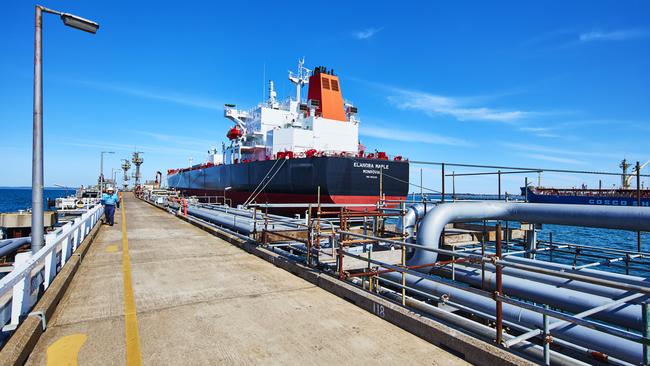
Reality has emerged and with the Lytton refinery in Queensland losing $59m in the first half, $81m in the third quarter and $141m year to date, few could blame Ampol boss Matt Halliday.
With the government still putting the final touches to its energy security plan, it is also an excellent time for Halliday to be raising the warning flags.
It’s early days yet and all Halliday has said is that the operation is under review, with a decision due by June next year.
It should be noted he is on the record as saying in good days an integrated local supply chain works best for the company.
Still, suffice to say, with Scott Morrison and Josh Frydenberg selling their rescue package for the economy in the run-up to a perceived election in the second half of next year, it’s exactly the news the government didn’t want to hear.
Big oil knows how to play the politicians.
This, of course, assumes the decision is to shut Lytton, which is not yet a given, in part because who knows what extra goodies are available.
Ampol earns revenues of $20bn a year in part because it collects about $7bn in taxes for the government, but this is too much to qualify for any of the budget investment allowances.
Just last month Taylor promised an import surcharge of $1 a barrel in an attempt to boost comparative Australian refinery profitability, but the sad reality is the sector has long been troubled and COVID-19 has simply emphasised the gloom by killing demand globally.
The policy dilemma for Taylor is he wants to ensure Australia meets its fuel security needs and understands the benefits of well-run local refineries with lower costs in helping to meet those needs.
The issue is how to ensure local refining continues profitably to ensure it plays its role in boosting Australian fuel security.
Last month Viva’s Scott Wyatt flagged the closure of his Geelong refinery only a week before Taylor’s projection plan was unveiled.
Now Ampol has its hand out, and it must be only a matter of time before BP in Kwinana and Mobil, which has reportedly had its Altona refinery on the market, will be stating the bleeding obvious that they can’t compete with the bigger Asian terminals, particularly in a time like now, when demand has collapsed.
In a good year, Ampol earns about $800m before interest and tax, with the refinery accounting for a quarter of those earnings.
The industry talks in terms of refining margins, but the term more accurately would be import replacement costs, which stand now at about $4.80 a barrel, against local production costs a bit over $6 a barrel and long-term margins of more like $10.50.
The international industry has been decimated by COVID-19, with demand disappearing and there is overcapacity globally, all of which makes it difficult for price takers like Ampol to make money.
Taylor is still working out the fine details of his plan, but the bottom line is he wants the petrol companies to ensure there is enough diesel available for 28 days supply and enough petrol and aviation fuel to last 20 days. This can be supplied by local refining, including locally produced oil from Bass Strait and elsewhere, by imports or through third-party holdings.
Either way, the choice is left to the petrol companies to make their own commercial decision, knowing the costs of either importing or the vagaries of local production when the entire capacity of the Australian industry is less than the smallest Asian refiner.
As Ampol’s Halliday makes his decision, Scott Wyatt at Viva and their counterparts at Mobil and BP will be doing the same sums, weighed in part by the government’s final decision on penalties for not meeting the reserve requirements.
Shutting a refinery is also not cheap, with Kurnell’s conversion to an import terminal costing the then Caltex $430m in 2014.
Interest in bonds
Buried in the federal budget was a note showing offshore holdings of Australian government securities had fallen from 76 per cent in 2012 to 53 per cent at the end of the last financial year.
The good news is increased local interest in the bond market, which is driven in part by the fact the RBA now holds about 7 per cent of the market having spent $53bn buying government debt this year.
New bank capital rules allowing banks to borrow at 25 basis points from the RBA come with a requirement that the money is invested in local debt, which has increased so-called bank balance sheet purchases.
There is now $704bn in government debt traded, which is a fair change from 2002, when the concern was the bond market would disappear because there was no debt and the then treasurer, Peter Costello, issued $55bn in bonds to provide some sort of float.
Last financial year the AOFM issued $128bn worth of bonds and in the nearly four months this year $117bn has been issued.
The locals led by the banks have taken the lion’s share and foreigners have also been buying, but just not at the same rate.
Boost for telehealth
Another budget snippet was the $111.6m allocated for the 2021 financial year for telehealth, which extends the lifeline until March.
Health Minister Greg Hunt is thankfully committed to telehealth, which has been one of the breakthroughs from COVID-19, and he is now working with the industry on the long-term plans.
There are also talks on how to get more home clinician visits, but this is still in the discussion phase.
Private health got the extension of family insurance to lift the child support age to 31, which was welcome, but the long list of industry reforms is sitting on the bench, as it is for the rest of the economy.
The government is perceived to be in election mode already, so based on past performance the chance for groundbreaking reform in the next year is not great.
Comyn’s CBA magic
Next Tuesday’s CBA annual meeting will see a strong no vote against the proposed $1.6m equity grant to chief Magic Matt Comyn but with the ASA, ACSI and two out of three proxy advisers in favour it should pass muster.
Comyn’s realised pay has increased from $2.8m to $3.9m in the last year, which compares to the median pay for the top 100 companies of $4.1m (75 times the population’s median pay).
Jefferies analyst Brian Johnson is one of many who rank CBA as the top performer among the big banks, and in the last 12 months it has outperformed its peers in performance and stockmarket terms.
Comyn’s realised pay will look a lot better in years to come because the equity vesting now is pre-CEO days, but if shareholders want pay for performance then he has beaten the hurdles.





The federal government was hoping business investment would drive the COVID-19 recovery, but just days after the budget and a few weeks after Energy Minister Angus Taylor promised some import protection, Ampol has flagged the potential closure of its Lytton refinery in Queensland.